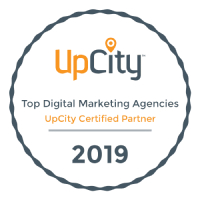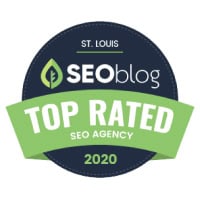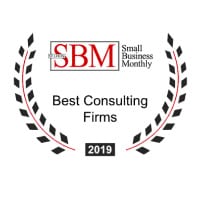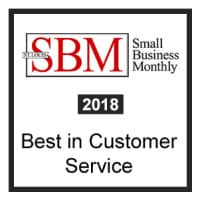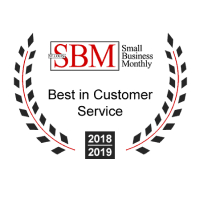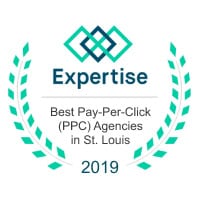This past week was an exciting one for Seafoam. Aside from celebrating our eighth year of being in business, we also added two crew members to our team!
Keep scrolling to see what Seafoam’s founder, Nikki Bisel, had to say about growing our company, and get to know the new members of our team!
 Eight years and beyond. — Q&A with Nikki Bisel
Eight years and beyond. — Q&A with Nikki BiselWith every year that we’ve been in business, we’ve had so much growth — not just in terms of revenue or number of employees, but in our processes, how we do things, how we take care of our clients, and the quality of our work.
I’m happy and proud that we’ve been alive for eight years, because a lot of businesses don’t make it that long. It’s comforting to know that we’re beyond that dreaded five-year mark by a good chunk, but for me, it’s more about looking forward. I’m grateful that we’ve been around for eight years; I’m even more grateful of all the development and evolution that has happened in those eight years, but I’m even more excited about each and every year to come.
If anything, what it means for me that we’ve been around this long is that I now have eight years of experience seeing the growth and evolution of the company, so I know that I can be legitimately excited about each year moving forward based on that experience.
People, people, people! There is no magic pill – no magic wand – for anything, whether it's helping to make our clients successful or growing Seafoam itself. It’s about good people and diligent, hard, honest work, and finding the right people for the right positions in this particular culture. When you find those perfect fits, it just works. Finding a round peg for a round hole makes things a lot easier.
There are two things I’ve learned...
First, you’re moving one chunk at a time. It’s awesome and necessary to have big, hairy, audacious goals, but the only way you get there is by reverse-engineering it — breaking it down into tangible, bite-sized pieces and working one step at a time.
Second, there will always be lessons to learn — to not get upset when I or we as a company make a mistake somewhere. It’s not about the mistake; it’s about how we recognize it and fix it so that it doesn’t happen again, and that’s how we become a better company. Every mistake is just an opportunity to one-up our competitors and to be a better version of ourselves.
That’s hard. I know so much more now than I did eight years ago, but I think that’s just life. Unless I could take the knowledge that I had from eight years of running this company back in time, I’m sure there are things I would do differently, but I can’t. I think, looking back, if there was one thing I could tell myself when I started Seafoam, it would be all those lessons: There are going to be mistakes. There are going to be hiccups. That’s life. That’s business. But when you persevere and you just keep pushing forward toward a vision that you have, that’s what will propel you forward.
I’m not one to focus too intently on revenue or number of employees, because I think those are shallow numbers. But on a very broad level over the next decade, I want to keep growing. Sure, we’ve set goals for things like revenue, but for me, it comes down to the reputation of Seafoam. I want to be the most well reputed marketing consultancy and agency in St. Louis, and then the midwest. I want every client we have to want to brag about us, and I want every team member we have to want to brag about the rest of their team.
 Holly Wentworth — Brand Engagement Specialist
Holly Wentworth — Brand Engagement Specialist“I’m a Brand Engagement Specialist. In short, I advance brands’ digital landscape, one video or picture at a time. Every great company needs a great social media presence to back it up. It’s my job to take care of that in a strategic way that will build your client-base exponentially.” — Holly Wentworth
 Madi LaChance — Marketing Challenge Intern
Madi LaChance — Marketing Challenge Intern“I am Madi LaChance, and I am a Seafoam Marketing Challenge Intern at Seafoam Media. I took an interest in marketing to broaden my skills. I like to work hard; it’s fun to have the chance to build on a big project and to put my energy into something.” — Madi LaChance
 The Seafoam Marketing Challenge is a program designed to give local high school students real-world marketing experience by intertwining their learning curriculum with the marketing needs of an area non-profit.
The Seafoam Marketing Challenge is a program designed to give local high school students real-world marketing experience by intertwining their learning curriculum with the marketing needs of an area non-profit.
Throughout the semester, student teams will have the opportunity to learn from Seafoam's marketing team, gather research data on the non-profit client, use this data to map out a marketing strategy for the client, and build their strategies into actual marketing materials.
At the end of the semester, the student teams will compete with one another by presenting their marketing strategies to Seafoam's leaders and the client. After a winning team is chosen, one to two students from this team will join Seafoam Media as summer interns where they will actually put their winning marketing strategy into motion for the client.
Future Seafoam Marketing Challenges will be listed here as they become available.
The Seafoam Marketing Challenge is a program designed to give local high school students real-world marketing experience by intertwining their learning curriculum with the marketing needs of an area non-profit.
Not only will students be taught how to gather research data on their non-profit client, use this information to map out real marketing strategies, and mold their strategies into tangible materials, but the winner of the competing teams will actually have the opportunity to launch their marketing strategy for their client this summer.
At Seafoam, we’re geeks about what we do. We love to share ideas about digital marketing with one another, with our clients, and with the public. In this quickly-changing space, we know that young people will drive innovation in the future. It’s that awareness, along with our desire to give back to the community we love, that has inspired us to reach out to local students.
As this project unfolds throughout the spring 2018 semester, this page will be periodically updated with the latest news, content and progress.
In the meantime, let's meet our participating high school and non-profit organization!
 MAPLEWOOD RICHMOND HEIGHTS HIGH SCHOOL (MRH)
MAPLEWOOD RICHMOND HEIGHTS HIGH SCHOOL (MRH)Located in Maplewood, MO, Maplewood Richmond Heights high school is "designed to meet the needs of the 21st century learner. We pride ourselves on our diversity and emphasize our personal touch with students. Technology is part of our daily learning as is our emphasis on health and wellness. Our students are our greatest assets and we continue to invest heavily in their futures."
To learn more, visit MRH's official home page.
 NATIONAL ALLIANCE ON MENTAL ILLNESS (NAMI) ST. LOUIS
NATIONAL ALLIANCE ON MENTAL ILLNESS (NAMI) ST. LOUISWith several locations spread throughout the St. Louis area, the National Alliance on Mental Illness St. Louis' "mission is to improve the quality of life of persons with severe and persistent mental illness and their families, and promote and provide community support, education, advocacy, and understanding."
To learn more, visit NAMI St. Louis' official home page.
Thanks to everyone at MRH and NAMI St. Louis who made the Seafoam Marketing Challenge possible. We can't wait to get started!
February 7, 2018 — Seafoam's Owner and Founder, Nikki Bisel, and Brand Manager, Zach Laidlaw, join Christi Patterson of NAMI St. Louis to officially kick off the Seafoam Marketing Challenge!
For a deeper dive into this program and what it means for MRH, NAMI STL and Seafoam Media, check out the video below.
MASSIVE shoutout to Pam Withers, John Capuano, Otto Schultejans, Sean McCrary (the man behind the camera) and the awesome marketing students at MRH! This program could not have been possible without you any of you. We can't wait to see what you guys build for NAMI St. Louis.
March 1, 2018 — It’s safe to say that no two marketing strategies are alike. Not only do these strategies change based on a brand’s wants and needs, but their goals and mission will largely influence their digital route to success, as well.
The differences become even greater, still, when breaking down a client’s business structure — particularly when it comes to for-profit companies versus nonprofit businesses.
Click here to read some of the things our team has to share about nonprofit marketing.
March 7-8, 2018 — This week, the marketing students at MRH joined the Seafoam St. Louis internet marketing team at our headquarters in Maplewood to show off their preliminary research and marketing strategies that they pulled together for NAMI STL. After viewing the presentations, Seafoam's team provided constructive feedback for the students to fine-tune their strategies before they give their final pitches in April.
Overall, the students' presentations were insightful, creative and aspirational. We can't wait to see how the students receive our feedback and inject it into their marketing strategies.
Shoutout to Mrs. Withers and Mr. Capuano for escorting the students from MRH for this rendezvous! Our team had fun spending time with you all!
Several weeks ago, we discussed the do’s and don’ts of nonprofit marketing strategies. This week, we’re diving back into the world of nonprofits to discuss how you can make the most of your marketing funds.
When it comes to fueling a marketing strategy, maintaining the proper budget is key to maintenance and growth.
This can be particularly difficult with nonprofit organizations. Since their funding typically comes from donors and fundraising events, nonprofits don’t have the cash-flow that larger brands rely on. Therefore, maximizing spending is critical to a nonprofit’s marketing success.
Here are some tips for your nonprofit to consider as you map out your marketing budget.
Marketing can be a complex beast to tame. There are many facets involved in online success; we often talk about the main four pillars with our clients: content, social media marketing, search engine optimization (SEO) and St. Louis website design/development.
This is just the beginning, though. Within each of these pillars, there are more, potentially expensive, pieces to consider, such as the types of content you want to create, which social platforms your nonprofit belongs on, the extent of your SEO, and the depth of your website’s design and functionality.
If your nonprofit is strapped for cash, you probably don’t have the funds to tackle the high end of each of the marketing pillars, but you should at least have the basics:
Marketing doesn’t always have to cost money; sometimes, it just takes a bit of precious, valuable time.
You can put the word out about your nonprofit by doing things such as:
Who is better qualified to run your nonprofit’s marketing strategy than an agency whose mission is to help brands succeed online?With the Seafoam Marketing Challenge, our agency was lucky to find willing participants to help us launch the first round of our new program. And now, as a result of Seafoam and MRH working together, the National Alliance on Mental Illness (NAMI) St. Louis will receive a free marketing strategy that they otherwise would not have had.
You never know what unconventional opportunities are available to your nonprofit until you go looking for them — or until the right moment presents itself to you.
It’s safe to say that no two marketing strategies are alike. Not only do these strategies change based on a brand’s wants and needs, but their goals and mission will largely influence their digital route to success, as well.
The differences become even greater, still, when breaking down a client’s business structure — particularly when it comes to for-profit companies versus nonprofit businesses.
In partnership with Maplewood-Richmond Heights High School (MRH) and the National Alliance on Mental Illness (NAMI) St. Louis, our team recently had the opportunity to shift our line of thought from the for-profit brands we usually represent to a local nonprofit organization that’s striving to make a difference in the St. Louis area.
Here are some of the things we have to share about nonprofit marketing...
Building a marketing strategy for a nonprofit is significantly different than building a strategy for a for-profit brand.
Why?
The differences are largely determined by the variations in each brand’s primary mission.
For-profit brands exist to make money from their products and/or services. They may be motivated by other endeavors, like making the best products they can or building a superior customer experience, but at the end of the day, for-profit companies want to make money and thrive so that they can continue to build new products and services that their customers will enjoy.
Nonprofit brands, on the other hand, exist to help their customers live better lives through their products, services and message. All funding that a nonprofit receives will be used to pay for the expenses of running the business (employee salaries, bills, etc.); the remaining money will be invested back into the organization’s goals and mission to help their community. For this reason, nonprofits don’t typically have the capital that for-profits brands have.
Our team’s journey into nonprofit marketing is just beginning. If you’d like to keep up with the progress the MRH students have made for NAMI St. Louis, visit the official Seafoam Marketing Challenge landing page to learn more! We’ll have much more to share over the next several months.
After more than a year of strategic thinking, planning and building, Seafoam has finally launched a brand new project that we’re excited to set out into the wild.
Earlier this month, we stormed the walls of the Maplewood-Richmond Heights High School to launch the Seafoam Marketing Challenge!
What is the Seafoam Marketing Challenge and why is it important to not only our community, but the local digital marketing industry? Here’s everything you need to know…
The Seafoam Marketing Challenge is a program designed to give local high school students real-world marketing experience by intertwining their learning curriculum with the marketing needs of an area non-profit.
This semester’s client is the National Alliance on Mental Illness (NAMI) St. Louis, an organization that aims to eliminate the stigma around mental illness and show those who are diagnosed that there is a positive way forward.
Not only will students be taught how to gather research data on NAMI St. Louis, use this information to map out real marketing strategies, and mold their strategies into tangible materials, but the winner of the competing teams will actually have the opportunity to launch their marketing strategy for NAMI St. Louis as an intern alongside Seafoam’s team this summer.
At Seafoam, we have a mathematical equation that guides everything we do (maybe you’ve heard of it?): 1+1=3. It’s the idea that our team strives to maximize the capabilities of our everything we do. Why should the Seafoam Marketing Challenge be any different?
The thing that probably excites our team most about the Seafoam Marketing Challenge, other than the fact that we’ve never heard of any other agency launching a program such as this one – local, national or otherwise – is that this program has the power to impact so many different groups of people.
Prior to partnering with Seafoam, MRH already had a full-functioning marketing program led by Pam Withers. When we proposed taking her marketing course to the next level by adding our input to the mix, we were more than thrilled to have her full support.
Not only does Pam ensure our program is implemented each and every week, she has also been integral in refining the ideas that Seafoam brought to the table.
With the help of Pam, as well as MRH’s Coordinator of Educational Exploration, John Capuano, and English/Journalism Teacher, Otto Schultejans, the Seafoam Marketing Challenge was able to grow into a program worth launching.
As with every client Seafoam partners with, NAMI St. Louis’ success is at the forefront of the Seafoam Marketing Challenge. Just like in a real agency, NAMI St. Louis’ marketing strategy has been given over to the students. It will be up to them to conduct brand research, build creative assets and present their final materials to Seafoam and NAMI STL’s teams. After a winning project is chosen, students from that team will join Seafoam this summer where they will execute the strategy they built and measure the results it produces for NAMI St. Louis.
The final piece of the Seafoam Marketing Challenge triad revolves around the way this program helps cultivate the next generation of marketing leaders in the St. Louis area.
One of our goals of this program is to provide students with real-world marketing experience — a benefit that most college students don’t even have by the time they receive their degrees. Students’ abilities to communicate, collaborate and create will be tested throughout this entire semester.
In the end, we hope students will be able to use this experience to excel in their higher education studies and launch their careers in the marketing world.
Furthermore, we want the Seafoam Marketing Challenge to serve as a way to get students excited about our industry — show them why now is the best time to consider career in digital marketing. We hope to help them leverage their creativity and strategic skills so that they can make something that they can be proud of and that produces measurable results for a real brand.
At the time this article was published, the Seafoam Marketing Challenge has only been active for two and half a weeks of its maiden voyage. There is still a large portion of the school semester left, so it’s hard to say what the future holds.
We fully expect for research to be conducted, mistakes to be made, lessons to be learn, and more. When launching a program that connects so many different groups of people and tests their limits of creativity and strategic thinking to make something truly unique, we don’t expect things to be perfect on the first round.
That’s why Seafoam’s team will be touching base with MRH’s students throughout the Marketing Challenge to ensure everything stays on track and that NAMI St. Louis receives a strategy thorough enough that it could have come straight from our agency.
Finally, if we’re lucky, we may just be invited back to MRH in the fall semester for a sequel to the Seafoam Marketing Challenge. But that’s a story for another time...
 Last week, we revealed how our readers and social media followers prefer to keep in touch with their family and friends. Just to quickly recap, here’s what you all had to say:
Last week, we revealed how our readers and social media followers prefer to keep in touch with their family and friends. Just to quickly recap, here’s what you all had to say:
Today, our team weighs in on the dangers of brands infringing on consumers’ personal communication bubbles, historically through the use of telemarketing and now text message marketing.
Raise your hand if you’re a fan of cold-call telemarketers.
Yes? No? Maybe? Probably not.
Telemarketers have gotten a bad rap over the years because of the unsolicited sales tactics that have often been employed to turn unsuspecting people into quick money.
That’s not the best business model if your goal is to cultivate a family of loyal customers who trust and invest in your products and services.
And now that texting is a widely used form of communication, brands have started to employ this marketing method to engage customers. In fact, early last year, Business.com wrote an entire article encouraging the industry to use text message marketing.
But is this really the best advice? Knowing how the public perceives unsolicited telemarketing phone calls, could text messages sent by brands become the next marketing red flag?
To help answer this question, we asked our team to weigh in on the gravity of solicited and unsolicited phone calls or text messages from brands. Here are just some of the things they had to say:
"I don't answer. Life is too short and my phone is too busy. I save my phone time for calls that matter to me. (In my early 20's I took great delight in messing with telemarketers so I feel like this is kinder. Me and my roommates used to see how much of their script we could get telemarketers to spell for us.)" — Liz
"They are mildly annoying, but I don't mind too much. If cold calling didn't work, they probably wouldn't do it." — Brian
"Only mildly bothered because, honestly, I don't answer. If I don't recognize the number I let it go to voicemail. If, on the odd chance that I pick up, I discover it's a sales call, I hang up. I'm, uh, pretty protective of my time I guess." — Holly
"Okay if I specifically asked them to call me. Can't stand when I'm forced to enter my phone number when signing up for something and then they use it to call me 10 seconds later." — Nikki
"I am okay with this, and will anticipate clearing out time to talk." — Jake
"I don't think I've ever expected a call from a telemarketer, but if I ever did expect a call, I wouldn't be angry." — Courtney
"Ew. Delete." — Nikki
"Anger, rage, and rapid unsubscribe." — Liz
"In my opinion, text messages are reserved for only my family and friends. Brands can try to engage with me via email (click the SPAM button), on social media (ads are a necessary evil) and wherever else they may be, but texting me is a violation of my private communication bubble." — Zach
"These are cool. I save the numbers and add them to my contacts so that it looks like I have more friends than I actually do." — Brian
"Rage. I hate this. I resent the time I spent glancing at and immediately deleting the text. Not a way to gain my business." — Holly
"Okay usually - though I usually only sign up for stuff like this to get an instant coupon then I'm annoyed when they keep texting me." — Nikki
"If I have ordered a product from a brand, I don't mind receiving a, 'Hey, your item has shipped' or 'Your order is ready for pickup' message. Since texting is my personal communication bubble, I would prefer to receive these messages via email, but I will take a text message in this case, if I am expecting it." — Zach
"I always try and clear out any time to read expected messages and will invest in giving good feedback if they ask." — Jake
"I only want to see those if they're directly related to a recent transaction. Otherwise, see previous answer." — Holly
"It'd better be a coupon!" — Ashlee
If you would like to read more of our teammates’ responses to these questions, click here.
As with any brand, it’s important to understand your customers: their wants, their needs, and even their challenges. Then you have to employ your marketing strategy to satisfy these wants, needs, and challenges.
In addition to that, your marketing strategy should also respect your customers’ privacy and personal preferences. Your brand should appear where your consumers expect you to be and should refrain from occupying the spaces where you simply don’t belong.
As our team responses revealed, the majority of Seafoamers dislike or ignore unsolicited phone calls and text messages but don’t mind solicited phone calls and text messages.
Considering that our poll takers voted that phone calls and text messages were the preferred ways to stay in contact with loved ones, imagine how they would feel if brands regularly engaged these channels beyond their customers’ consent to sell their products.
But don’t let us put words in your mouth; speak for yourself! Tell us on our Facebook and Twitter pages what you think about receiving solicited and unsolicited brand communications via phone calls or text messages. Do you have an example of when a company communication went too far? How did that experience make you feel? What should the company have done instead?
We can’t wait to hear what you have to say!
 Communication is one of the most innate qualities of the human race. We crave conversation. We yearn for connection. We must engage with one another!
Communication is one of the most innate qualities of the human race. We crave conversation. We yearn for connection. We must engage with one another!
Okay, maybe the human race doesn’t want to talk all the time. Sometimes, there’s nothing more desirable than sitting in a quiet room with a good book or your meditative thoughts.
But eventually, instinct will take over, and you will want to engage with the living world once more.
In honor of the art of communication, last week, we conducted a poll asking you which way you prefer to stay in contact with your loved ones. This week, we reveal your responses, plus we leave a nugget for you to ponder on for our deeper dive next week.
The official results broke down into the following six categories:

When video chatting hit the mainstream with Skype in 2003, followed by Apple’s and Google’s competing services for mobile phones nearly a decade later, it was deemed a revolutionary way to connect people across long distances. While this may still hold true today, video chatting is one of the lesser preferred communication tools that our poll takers chose.
Face-to-face conversation is by far the oldest communication method on our response list (for obvious reasons). Unfortunately, speaking face-to-face with a loved one isn’t always as accessible as choosing a more technologically advanced approach, especially if these family members are far away from each other.
Since garnering public attention in 2003 with MySpace and passing the primordial torch over to Facebook in 2006, social media has played a large part in society’s lives ever since. Unfortunately, our survey highlights that private messaging hasn’t quite caught on as much as social media’s public side.
Social media is built for mass population conversation — thus, the “social” part of social media’s name. As a result, it probably comes as no surprise that our voters chose public posts, tags, comments, and shared content as the second most popular form of staying connected with friends and family.
The tried and true method of communication, phone calls have been connecting people to each other all across the globe since the members of the American Telegraph and Telephone Company (you know them now as AT&T) built the first telephone line in 1877. Despite the technology that is available today, phone calls are still tied for our voters’ number one preferred method of reaching out to loved ones.
Like many aspects of technology, text messaging has come a long way. Before touchscreens or even keyboard-equipped BlackBerry phones, texting started as a somewhat primitive way to send short messages to friends and family in lieu of a phone call.
To even write a message as simple as, “Sorry, I’m going to be late,” users had to repeatedly tap the 9 dialing buttons on their non-smart cell phones to spell out words. This time-consuming task led to abbreviated language – “Sry, I’m gonna b l8.” – and paved the way for texting advances, such as T9.
The holy grail of texting, however, would ultimately be ushered in by smartphones that could utilize touchscreen interfaces to replicate various types of typing experiences.
Because of texting’s gradual evolution, this method of communication is still one of the quickest, simplest, and most convenient ways to connect with family and friends.
Go ahead and take a look at this list of responses again. What do you see?
This list doesn’t just highlight how people prefer to stay connected. It’s also a shortlist of ways that marketers and sales associates have tried to engage customers over the years:
Out of the list above, look at the two preferred methods of communication that our poll takers chose: phone calls and text messaging.
Now think about how the marketing industry has already used one of these methods to impact society and how the other method of communication has the potential to follow in its predecessor’s footsteps.
What are the positives of using these communication bridges as marketing tools? What are the negatives? Do the pros outweigh the cons, or vice versa?
Join us on The Anchor next week as our team discusses how you can use this information to benefit your customers and your brand.
Thanks for reading, and stay tuned!
* This survey was distributed through Seafoam’s social media channels. Participants were only allowed to vote once. Answers could not be changed after submissions were finalized. All data and information transmitted through this survey were completely anonymous.
In a report that came out earlier this week a major ad technology firm, Criteo, cut its 2018 revenue by more than one-fifth as a result of Apple’s anti-web tracking services baked directly into their Safari browser on iOS devices and macOS computers.
Should the marketing industry be worried about its future? We discuss the nitty gritty...
Step out your front door and walk to your nearest coffee shop, grocery store, or any other place that is frequented by humanity. Then look around. What do you see?
More often than not, you’re going to see a lot of people of various ages staring down at those handheld windows to the web we call smartphones — you’ve probably heard of them.
Now look closer, still. What do you notice about these smartphones? If the latest metrics are worth their salt, you’ll see that at least one-third of the devices in any one area are Apple iPhones. Combined with the community of Mac users, Apple’s default web browser, Safari, accounts for 15% of global web surfers — a small but significant portion of users.
Why is this important?
It’s no secret that the open and free internet has long been powered by specially placed advertisements. Without ad revenue, websites that don’t sell products – such as news media or entertainment sites – simply would not have the funds to exist.
This is similar to how network television operates: you have a free series of channels that you can watch with segments of commercials sprinkled in between in order to keep your favorite networks (and shows) on the air.
Unlike television, however, ad agencies quickly learned that the internet held much more advertising potential than television. They could leverage unique identifiers, such as IP addresses, wifi data and cookies to follow users around the web and record their interests to serve consumers more relatable ads, thus increasing the chances of users purchasing products as a result of these ads.
Unfortunately, this is where the line between “creative marketing” and “creepy marketing” starts to blur. Turns out, many online users don’t like advertisers recording every move they make across the web.
In the age of technology where people post everything from their deepest feelings, their greatest experiences, and even their picture-perfect lunches to social media (you know you do), society actually values privacy now more than ever.
People want to be in control of what they share with the world wide web and what they don’t — not ad agencies and brands. Unfortunately, due to the tracking techniques employed by some of the largest ad companies in the world, the people of the internet weren’t always given this right. In fact, many online users – maybe even you – have been exploited.
For instance, have you ever researched a certain product or service on Google just to find ads for this same product or service pop up in your Facebook feed days later? If so, you’ve been targeted by an ad agency.
This behavior led major technology companies, like Apple, to build and implement solutions for their customers.
That leads us to a simple proclamation: ads simply aren’t enough anymore. They’re not enough for brands, they’re not enough for consumers, and frankly, they’re not enough for marketing firms of any size, location or demographic.
Ads by themselves are lazy on an agency’s part; it takes only a minimal degree of critical thinking to dispatch a bunch of static sales pitches to follow people around the web. And with tech giants like Apple fighting back, ads are now becoming less effective, as well.
Don’t get us wrong. As a marketing consultancy + agency, Seafoam’s team understands the importance of ad placement. But serving a few ads to anonymous groups versus siccing a targeted barrage upon individual human beings is very different, especially in terms of individual privacy.
It shouldn’t have taken something as disruptive as anti-web tracking services to make the marketing industry stop and think about how they relate to their customers. It’s our job – the industry’s duty – to provide client services and customer experiences that do not breach humanity’s trust.
In short, anti-web tracking services are keeping the marketing industry honest by promoting a sense of humanity and invoking creativity to engage with customers – not turn them into dollar bills as quickly as possible.
So where do we go from here? If you read the last paragraph, you already know the answer:
Engage with humanity.
As targeted ads lose more and more ground to anti-web tracking services, the marketing industry will have to cultivate more influential ways of connecting with customers.
We predict that content marketing will continue to strengthen throughout the next several years; video will be extremely important, and although the written word may cede some ground to more visual presentations, blogging should still have a place in your strategy. The importance of human-to-human social media engagement – especially during this time of fake news and social media turmoil – will be paramount to brand success. Finally, creating real-time value for consumers will make the difference between earning their trust or losing them to a competitor.
Now that you’ve read our thoughts on anti-web tracking services, how they have impacted the marketing industry, and what marketers should do to combat this growing trend, it’s your turn to weigh in!
Share your thoughts with us on Facebook or Twitter. We’d love to hear what you have to say on the subject.
And as always, thank you for stopping by The Anchor by Seafoam Media. We’re grateful for the chance to spend some time online with you.
SOURCE: The Guardian
It’s that time again.
A cold chill’s in the air.
The leaves have turned down.
Autumn is here.
And as the clock rolls over,
Toward another year gone by.
Friends and family will gather,
To reflect on the good times.
You’ll sit to give thanks,
To spread holiday cheer.
Here are some things,
We’re thankful for this year.


So what are you thankful for this year? Has 2017 turned out to be everything you hoped it would be? Do you have any plans to make 2018 even better? Share your thoughts with us on Facebook and/or Twitter. We’ll be checking our feeds in between munching on turkey legs and pumpkin pie.
Happy Thanksgiving!
It’s no secret that the two largest shopping holidays of the year are quickly approaching: Black Friday and Cyber Monday. To kick off the holiday shopping season, we conducted a survey two weeks ago that asked one simple question: Where do you shop online?
This week, we’re diving into the poll results, as well as analyzing how these findings can potentially impact your brand's marketing strategy this holiday season.
Our poll results were broken down into five categories:

The gold-standard of success for any brand is name assocation. When you think of laundry detergent, a specific brand probably pops into your mind. The same goes for soft drinks, smartphones and certain food items (eggs, bread, milk, etc.).
For many loyal customers, the best place to buy a certain brand’s product is to visit their website directly. For our surveyed audience, however, this was not the most effective way to make an online purchase.
Now, there are many reasons that may drive a customer to seek a product elsewhere than the manufacturer’s website — potentially too many reasons to discuss in this article. Whatever those reasons may be, the results of our survey are apparent: a manufacturer’s website is not the first place the majority of people will look.
Google is undoubedtly a great tool to help users research products, read reviews and even find the various online outlets where products are sold. But based on the data culled from our survey, it is clear that there’s one thing our audience isn’t using Google for: to actually buy products.
This fact may be one of many reasons that Google recently integrated its shopping service with one of the world’s largest retailers, Walmart. Only time will tell if this strategy helps Google Shopping and/or Google Express gain more public traction.
Rounding out our lowest group of rankings, a small percentage of users polled preferred in-real-life shopping experiences to purchasing items online. Old habits die hard, and when it comes to shopping, some customers prefer walking into a store and holding the items they intend to buy.
Before primarily online retailers existed, the shopping scene was ruled by major retailers, such as Target, Walmart, Macy’s, JCPenney, etc. For these chains that were able to scale their in-person shopping experiences to the world wide web, our survey shows that many customers have maintained their retailer-buying habits when it comes to purchasing items online.
Unfortunately, it can be difficult for brands – particularly smaller businesses – to build relationships with major retailers that lead to the likes of Target and Walmart stocking their products for online sale.
Speaking of brand name association, there is one company that almost always comes to mind when the words “online shopping” are spoken. Serving as one of the largest online distributors in the world, the majority of our polled audience agrees that Amazon is the first place they go when purchasing products over the web. To many of our readers, this result is probably no surprise.
When looking at the poll results, the chart above says it all: if your brand’s products aren’t listed on Amazon, you’re potentially missing out on more than half of your annual revenue!
Of course, that doesn’t mean that your products should only be on Amazon.
Having your own eCommerce segment of your site that is search engine optimized and crawlable by the likes of Google is important to your brand’s online ranking and exposure. Even if this isn’t where you will make the majority of your money, having eCommerce can help your customers find and learn about your products before they make a purchase.
From a big-picture perspective, it’s best to anticipate everywhere your customers are likely to look for your products and accommodate them appropriately — not just accommodate some of your customers in some of the places they will be. Your brand has a duty to make it as easy as possible for your customers to invest in your brand.
Okay, so now that you know where your products should be for your online customers, it’s time to look at your business’ online selling strategy. Start by asking yourself the following questions:
Even if you don’t have all the answers to these questions by Black Friday or Cyber Monday, the holiday shopping season is just beginning. There is still plenty of time to get your online strategy squared away, but you have to start now.
If you liked participating in our survey and reading our responses breakdown, please hit the “heart” in the top right corner of this article.
To know when future surveys are posted, as well as their results, follow Seafoam on Facebook, Twitter and LinkedIn. We look forward to connecting with you!
* This survey was distributed through Seafoam’s social media channels. Participants were only allowed to vote once. Answers could not be changed after submissions were finalized. All data and information transmitted through this survey were completely anonymous.
Success.
It’s a simple word that can make the difference between a business thriving in its market space or closing up shop for good. It’s what all brands want to achieve, yet only a tiny fraction of businesses even come close.
This fact can be scary for entrepreneurs, startups, investors and even large conglomerate chains that have experienced the unforgiving fury of failure.
But what if you could guarantee that your business doesn’t fail? It sounds like fiction, but there is a way to keep your customers happy while ensuring your profit margins continue to grow for decades to come.
Think of a brand that you consider successful. The company can be in any industry and can be any size. You might be thinking of one of the technology giants in Silicon Valley (we talk about them a lot in our office). Maybe your favorite beverage company popped into your head. You could even be thinking about a local hotspot that serves the best burgers or frozen custard in town.
Whichever company you chose – if you look closely – has survived by adopting, implementing and maintaining three critical keys to success:
If your brand is a fine automobile, innovation is the fuel that propels it forward.
To many business owners, innovation can be an intimidating word with a lot of expectations. If you listen to the shareholders of a certain fruit-flavored technology company, innovation means inventing a new product or service that changes the way humans engage with the world every half-decade or so.
But to brands such as yours, this word doesn’t have to be so complicated. In its simplest form, innovation just means to “never settle.”
Looking back on your brand’s history, your company may have already done some amazing things. It may have already built a fantastic product for its customers or introduced a new ideology that changes the way your industry operates, and while this in itself is a great achievement, your brand cannot continue to grow by being satisfied with its past. You have to keep looking toward the future for inspiration: What else can your brand do to make its products/services better? Or what new products/services can you create to move society forward?
Like your favorite smartphone app, your brand should always be making improvements — iterating. Even if these changes are miniscule, the greatest threat to any brand is to stop building upon its future.
The world will inevitably continue to change. Your brand must change with it, or it will be left behind.
You may be asking yourself: What does humanity have to do with business? Everything, actually.
If you read over the last section on innovation again, you’ll notice several odes to humanity spread throughout it:
“Innovation means inventing a new product or service that changes the way humans engage with the world.”
“What new products/services can you create to move society forward?”
At Seafoam, we often talk about serving the people behind the businesses that we work with. Sure, a brand’s measureable income and success are important, but when scanning through spreadsheets upon spreadsheets of data each week, it can be easy to forget about the human beings who run these companies.
The same goes for your customers. These people aren’t just dollar bills on an earnings sheet. They are living beings with real wants, needs, concerns, emotions and more. They go to work to support themselves or their families, they pay bills to keep the lights on, and they face challenges, some of which may be even greater than those you’ve ever experienced.
As a company, it is your job to remember that your customers are human. What product or service can you, with all of your knowledge and industry expertise, provide so that your customers’ lives are truly better with your brand than they are without it?
This third key to success isn’t just here because we’re a marketing consultancy and agency. Marketing is really important.
The old adage states: “If you build it, they will come.”
If the proprietor of this saying lived in a small town where everyone knew his/her name, this may have been true. But today, as millions of businesses compete to sell their products and services in real life, as well as across the web, this saying no longer suffices. Street corners and online spaces are chalked full of companies trying to sell their products to turn a profit.
What makes your company unique?
In addition to innovating and keeping humanity at the forefront of your business strategy, good marketing is how you break through the noise. Without it, search engines, like Google and Bing, cannot find your brand and show it to the people who are looking for the products/services you sell. Your business is less likely to appear in Google Maps, thus preventing consumers from visiting your business.
Without marketing, your brand and all the hard work associated with it is invisible. If you’re invisible, you perceptually don’t exist. And if you don’t exist, consumers cannot find you, see what you sell and invest in your business.
By the time you reach this final section of our article, you most likely already know how your company fits into the business model outlined above. You know if you have neglected one or more of the keys to maintaining a successful brand. You also know if this neglect has begun to impact your month-over-month earnings.
The good news is: if you have neglected any of these keys to success, now is a good time to reorganize your priorities and get your brand back on track. As long as your business is alive, you have the power to make it better.
It’s difficult to have a conversation about marketing without the word “content” popping up.
Brands have been telling their stories for decades as a means to relay value to their customers, and although this narrative concept didn’t develop into a pinnacle of marketing until the early 90’s, content marketing has evolved into more than just the hottest buzzword in the industry; it’s become a brand necessity.
Unfortunately for businesses everywhere, creating content for content’s sake isn’t a viable strategy. Content marketing is only valuable when it is designed with a ubiquitous approach. Is your brand tapping into its full potential?
Here is everything you need to know about getting the most out of your brand’s content marketing strategy.
Essentially, content is a method of communication that engages a community of users (or customers) by means of creating and sharing ideas.
An extraordinary feature of content is that the manners in which ideas can be relayed are almost limitless; it encompasses a vast expanse of platforms to get messages across. For instance, content can transpire in the form of written materials (blogs, website copy, white papers, case studies, etc.), graphics (infographics, memes and GIFs), videos (Q&A’s, interviews, product showcases, etc.) and more.
Content is everywhere and in everything: in your social media feeds, on a television broadcasts, etched on billboards on your way to work, and it’s even embedded in the morning newspaper you may or may not read anymore. Unfortunately, just because content is omnipresent doesn’t mean it is always executed correctly, especially when it comes to businesses.
If you scroll through your favorite social media feed right now, chances are you’ll be greeted with a barrage of content revolving around various themes and topics. But in the race to go viral or to make an immediate impact on their audience, many companies who leverage social media will make this one critical error...
Oftentimes, brands will post content about what they do and why they’re good at what they do. This is a mistake, because if a brand is mostly speaking to their current customers – with the opportunity for new customers to occasionally trickle in – the majority of these customers are already aware of what the brand does and how good they are at doing it. Therefore, the brand’s content efforts are not being utilized effectively.
A better content strategy utilizes a dual-thought approach that not only places your brand’s content in front of the right people but also provides meaningful value to them.
A successful brand will be able to understand exactly who their audience is; it knows how to consider their customers’ questions and objections. Being able to engage customers in a way that helps anticipate their needs is key to sharing content that will be truly useful to them.
Once a brand fully understands its audience, it must be able to relay its solution to customers’ questions and objections in a subtle, yet effective way. The solution should avoid a hard sell at all costs. With this tactic, many customers will know when a company is simply trying to monetize them; the added pressure will likely drive customers away from your brand instead of toward it.
It’s important to nurture your audience in a way that is emotive and informative. Guide them through their questions and objections instead of slapping them in the face with information and a bottom line. This way, your brand’s customers will know you care.
For many brands today, their content strategies are rote; they get stuck in a vicious cycle of publishing material that may be relevant to their industry, but they neglect to consider the actual needs of their customers.
When left-brain processes are combined with right-brain creativity, your brand will be able cultivate a truly unique content strategy for those who matter most to your growth. Not only will this process help you get your content in front of the people who are more likely to respond to your message by investing in your brand, you will also be empowered to publish content that compels your audience to consume it to the end and crave what comes next.












